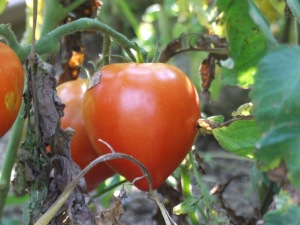 One of the biggest things that makes a difference, in my opinion anyway, is getting back to eating food in its most Natural state. Wouldn’t you rather eat this freshly grown tomato than one from a can? This one is from my garden, grown without chemicals or pesticides. No preservatives were used to extend its life and it tastes like a tomato is supposed to taste!
One of the biggest things that makes a difference, in my opinion anyway, is getting back to eating food in its most Natural state. Wouldn’t you rather eat this freshly grown tomato than one from a can? This one is from my garden, grown without chemicals or pesticides. No preservatives were used to extend its life and it tastes like a tomato is supposed to taste!
Guideline #2: Get as natural as possible with your food (eat as close as you can to its natural state)
Once I made the decision to “clean up my diet” the first thing I did was to really start reading labels. I was amazed at how many ‘preservatives’ and chemicals were in most products claiming to be good for you. Sugar, salt and fat are hidden in plain site–but under many names most of us don’t realize they are there. Start reading labels of what you are eating. Part of the problem is that its not illegal to list sugar as 3 different types to get ‘sugar’ off the top 3 ingredients to make it look healthier. Learn how to read labels to discover what is really in there.
Take a look at frozen meals. Now I am not saying you need to eliminate them totally, just be aware of what is there. Guidelines are fuzzy because if a ‘nutrient’ falls below a certain number they can round it down and call it zero. So much for honesty in labeling. Look at your label–if its high in sodium they might boost the potassium to ‘balance’ it out. The trouble is that the sodium is still there affecting your body.
My method to deal with it was to make as much of the food you eat from scratch. Yes, it does take a little more time and effort but that is part of eating healthier by planning ahead (Guideline #3). When you can take the wholesome parts and create your own meals based on what you like to eat (Guideline#4), and they are ready to eat, you are more likely to eat healthier less processed food.
One of my easiest things to make? Oatmeal. I love oatmeal! Don’t use the prepackaged ones, they are loaded with sugar and stuff. Use real oats, the old fashioned ones are great for on the stovetop–they cook in just minutes and you can use either water or milk as the liquid and add in any fruits you like. Top with a little maple syrup or honey and you are good to go. When it got warm I switched to “refrigerator oatmeal” which bumped up the nutrition with Greek yogurt and fruit. Now that it is cooler again I switched to “Crockpot oatmeal” which uses steel cut oats.
Another thing that is super easy? Vegetables! Spend a half hour (or less) prepping carrots, peppers, celery etc and keep it in containers so you can grab and snack. I eat them with hummus, peanut butter, salsa or even plain. By having them ready to go I eliminated heading to the pantry for chips and processed snacks.
No matter what you choose to do, the idea is to eat real food, the kind that does not need a label to know what it is. Try to eat fresh fruit and vegetable, lean meats (if not a vegetarian) and dairy/eggs in their most basic form and experiment with recipes to keep your food ‘clean’ from chemicals and additives. When you do use canned or frozen food, read your labels to understand what you are adding.
Let me know what you think. Do you think eating less processed food and more fresh food makes a difference?
